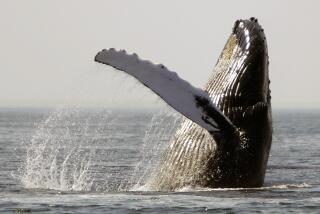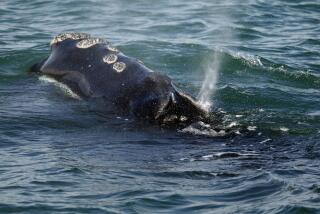There are the walrus: New way to tally the population
- Share via
ANCHORAGE, ALASKA — Alaskan researchers are joining their Russian counterparts in the most exhaustive effort yet to answer a simple question: How many walrus are there?
Without a good answer, it is impossible to know whether the marine mammals that live mostly on sea ice off the coasts of Alaska and Russia are being affected by global warming, say scientists on both sides of the Bering Strait.
“The size of the walrus population is unknown. We really have no idea,” said Douglas Burn with the U.S. Fish and Wildlife Service in Anchorage.
Without some basic knowledge, it is impossible for scientists to advise policymakers on whether walrus should join polar bears, now being recommended for addition to the endangered species list. The proposed listing is based largely on the belief that sea ice is melting.
Walrus, too, are dependent on sea ice. They give birth on the ice and rest on it. The hefty animals need ice that is at least 2 feet thick to support their weight.
A joint aerial survey to count walrus was conducted every five years between 1975 and 1990, when scientists estimated there were about 200,000 Pacific walrus. But researchers stopped after realizing it was not accurate.
Now, they are bringing modern sampling methods to the count, including a special tag, infrared scanning, a digital camera and satellite telemetry.
The survey area covers more than 38,610 square miles.
“It has to be done jointly, otherwise it doesn’t reflect the truth,” said Vladimir Chernook, department head of the Research and Engineering Institute for the Development and Operation of Fisheries in St. Petersburg, Russia. “The walrus don’t care about the border.”
The U.S. provided $1.5 million for the survey.
The improved count began with scientists at the U.S. Geological Survey developing a special transmitter that can tell when walrus are on the ice and in the water. Previous counts missed those in the water. A crude correction factor was applied, but the end result was likely an undercount, said Chad Jay with the U.S. Geological Survey in Anchorage, who helped develop the new tags.
The tags take into account wind speed, temperature, barometric readings and animal behavior in estimating how many walrus are probably in the water at any given time.
“It is a big issue. On average, walrus are in the water 80% of the time,” Jay said.
In March 2006, scientists used crossbows to attach about 50 tags over 10 days south of St. Lawrence Island, about midway between Russia and the U.S.
After about six weeks, the transmitter battery dies and the barb anchoring the device eventually works its way out of the blubber, Jay said.
The next month, more than 50 scientists, three airplanes and two icebreakers joined the survey. It was conducted over three weeks when the walrus were spread over the ice fields of the Bering Sea.
When the scientists detected a group of walrus, the infrared scanning was used to determine how much heat the walrus were producing. The intensity is used to calculate how many walrus were in each group.
The area covered is two to six times larger than the human eye can scan.
The summer will be spent refining the data. A preliminary count is expected by this fall.
During a recent meeting in Anchorage, the Russian scientists said anecdotal reports from native subsistence hunters on their side of the Bering Sea indicate walrus numbers are down.
“We see there is a decline in population probably due to global warming. We see high mortality in the coastal haulouts,” said Russian scientist Anatoly Kochnev.
More to Read
Sign up for Essential California
The most important California stories and recommendations in your inbox every morning.
You may occasionally receive promotional content from the Los Angeles Times.













